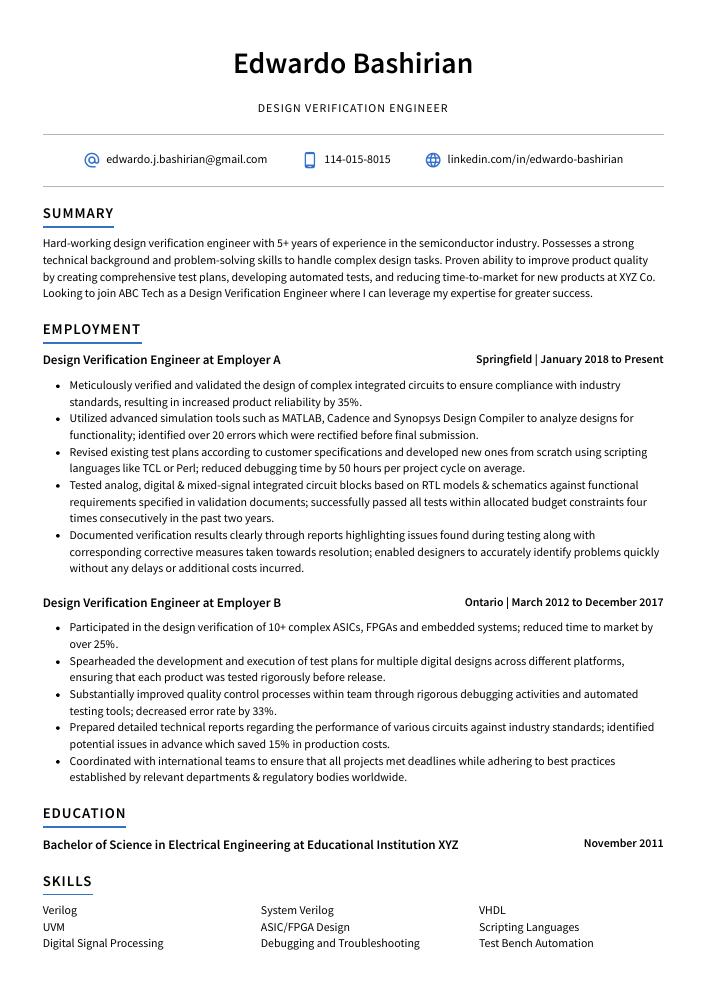Design Verification Engineer Resume Guide
Design verification engineers ensure that the designs created by hardware or software designers meet their requirements and are free from errors. They use various testing methods to verify a design’s accuracy, performance, reliability, and safety before it is released for production.
Your expertise in design verification engineering makes you an ideal candidate for any job. But potential employers don’t know who you are yet, so to get their attention, you must write a resume that highlights your qualifications and experience.
This guide will walk you through the entire process of creating a top-notch resume. We first show you a complete example and then break down what each resume section should look like.
Table of Contents
The guide is divided into sections for your convenience. You can read it from beginning to end or use the table of contents below to jump to a specific part.
Design Verification Engineer Resume Sample
Edwardo Bashirian
Design Verification Engineer
[email protected]
114-015-8015
linkedin.com/in/edwardo-bashirian
Summary
Hard-working design verification engineer with 5+ years of experience in the semiconductor industry. Possesses a strong technical background and problem-solving skills to handle complex design tasks. Proven ability to improve product quality by creating comprehensive test plans, developing automated tests, and reducing time-to-market for new products at XYZ Co. Looking to join ABC Tech as a Design Verification Engineer where I can leverage my expertise for greater success.
Experience
Design Verification Engineer, Employer A
Springfield, Jan 2018 – Present
- Meticulously verified and validated the design of complex integrated circuits to ensure compliance with industry standards, resulting in increased product reliability by 35%.
- Utilized advanced simulation tools such as MATLAB, Cadence and Synopsys Design Compiler to analyze designs for functionality; identified over 20 errors which were rectified before final submission.
- Revised existing test plans according to customer specifications and developed new ones from scratch using scripting languages like TCL or Perl; reduced debugging time by 50 hours per project cycle on average.
- Tested analog, digital & mixed-signal integrated circuit blocks based on RTL models & schematics against functional requirements specified in validation documents; successfully passed all tests within allocated budget constraints four times consecutively in the past two years.
- Documented verification results clearly through reports highlighting issues found during testing along with corresponding corrective measures taken towards resolution; enabled designers to accurately identify problems quickly without any delays or additional costs incurred.
Design Verification Engineer, Employer B
Ontario, Mar 2012 – Dec 2017
- Participated in the design verification of 10+ complex ASICs, FPGAs and embedded systems; reduced time to market by over 25%.
- Spearheaded the development and execution of test plans for multiple digital designs across different platforms, ensuring that each product was tested rigorously before release.
- Substantially improved quality control processes within team through rigorous debugging activities and automated testing tools; decreased error rate by 33%.
- Prepared detailed technical reports regarding the performance of various circuits against industry standards; identified potential issues in advance which saved 15% in production costs.
- Coordinated with international teams to ensure that all projects met deadlines while adhering to best practices established by relevant departments & regulatory bodies worldwide.
Skills
- Verilog
- System Verilog
- VHDL
- UVM
- ASIC/FPGA Design
- Scripting Languages
- Digital Signal Processing
- Debugging and Troubleshooting
- Test Bench Automation
Education
Bachelor of Science in Electrical Engineering
Educational Institution XYZ
Nov 2011
Certifications
Certified Verification Engineer (CVE)
IEEE Computer Society
May 2017
1. Summary / Objective
Your resume summary should be a concise and engaging overview of your experience as a design verification engineer. Include key skills such as coding, debugging, scripting languages, and test automation that you have mastered in the past. You can also mention any awards or certifications you have obtained related to this field. Finally, highlight how your expertise has helped companies achieve their goals by providing examples of successful projects you’ve worked on in the past.
Below are some resume summary examples:
Passionate Design Verification Engineer with 6+ years of experience in the semiconductor and electronics industry. Adept at creating high-level test plans, designing verification environments, writing and debugging tests, analyzing results to ensure quality assurance requirements are met. Recognized for outstanding performance that consistently exceeded expectations. Experienced in working with a broad range of tools such as SystemVerilog/UVM and C++ languages.
Talented Design Verification Engineer with 10+ years of experience in the design, verification and validation of complex digital systems. Experienced in developing test plans across multiple projects using industry-standard technologies (VHDL/Verilog, SystemVerilog). Skilled at creating UVM components to reduce system complexity and improve product quality. Proven track record of reducing project costs by 50% or more through innovative testing strategies.
Diligent design verification engineer with 4+ years of experience in verifying and validating the correctness and accuracy of integrated circuits. Experienced in developing test plans, writing scripts for automated tests, and post-silicon validation testing. At XYZ Inc., developed new design methodologies that improved production speed by 30%. Skilled at debugging complex issues to ensure designs meet customer requirements.
Determined design verification engineer with 5+ years of experience in developing and implementing test plans for complex electronic systems. At XYZ, developed a comprehensive system-level design verification plan that resulted in the successful launch of two products on time and within budget. Highly organized, detail-oriented professional capable of meeting tight deadlines while maintaining accuracy and quality standards.
Professional design verification engineer with 5+ years of experience in ASIC and FPGA designs. Experienced in developing test benches to verify the design, writing drivers and creating tests for simulation. Proven track record of successful debugging and implementation of complex systems on time by leveraging Verilog/VHDL coding knowledge. At XYZ, wrote test plans that improved system performance by 25%.
Well-rounded design verification engineer with 8+ years of experience in the semiconductor and electronics industry. Skilled at developing test plans, executing simulations to confirm design accuracy, and analyzing data for post-silicon validation. Seeking to join ABC Tech’s team of experts as a Design Verification Engineer to improve product quality while meeting stringent customer requirements.
Enthusiastic design verification engineer with 6+ years of experience in developing and executing test plans for complex digital designs. Skills include scripting, automation development, debugging tools, analog simulation, SoC integration testing and more. Seeking to join ABC Technologies as a design verification engineer to build world-class products using the latest technologies.
Amicable design verification engineer with 8+ years of experience in microelectronic design and debugging. Seeking to leverage knowledge of ASIC, FPGA and SoC designs to support ABC Tech’s development process. Previously reduced the time spent on logic simulations by 25% through an innovative testbench approach that improved quality assurance cost-efficiency by 15%.
2. Experience / Employment
In the experience section, you should provide details on your work history. This section should be written in reverse chronological order, with the most recent role listed first.
When writing this section out, it’s best to use bullet points and keep them concise. You want to include detail about what you did and any results achieved as a result of your efforts. For example, instead of saying “Verified designs,” you could say “Performed verification testing for new product designs using simulation tools such as VHDL/Verilog; identified 10+ design issues that were resolved prior to launch.”
To write effective bullet points, begin with a strong verb or adverb. Industry specific verbs to use are:
- Analyzed
- Simulated
- Validated
- Debugged
- Documented
- Developed
- Implemented
- Tested
- Troubleshot
- Optimized
- Monitored
- Investigated
- Resolved
- Executed
Other general verbs you can use are:
- Achieved
- Advised
- Assessed
- Compiled
- Coordinated
- Demonstrated
- Expedited
- Facilitated
- Formulated
- Improved
- Introduced
- Mentored
- Participated
- Prepared
- Presented
- Reduced
- Reorganized
- Represented
- Revised
- Spearheaded
- Streamlined
- Structured
- Utilized
Below are some example bullet points:
- Compiled and analyzed test results from verification tests and simulations to ensure that design specifications were met, leading to a reduction in product defects by 25%.
- Thoroughly reviewed functional designs for multiple integrated circuits (ICs) and identified potential issues with power supplies, signal integrity and thermal characteristics; suggested modifications which increased IC performance by 10%.
- Formulated test plans based on customer requirements, system-level simulation models & timing constraints which enabled the successful execution of complex RTL logic verifications.
- Expedited testing cycles using advanced scripting techniques while maintaining accuracy across five key projects; reduced overall verification time by 15 hours per project cycle.
- Achieved significant cost savings through efficient utilization of hardware resources such as FPGAs or emulators during Design Verification stages, resulting in a 20% budget cut over six months period.
- Assessed the functionality and performance of new designs against specified requirements; identified over 50 issues within the last 6 months, leading to a 15% decrease in overall design rework costs.
- Optimized test plans for integrated circuits, microprocessors and other complex electronic products while ensuring compliance with applicable standards & protocols; achieved a 100% success rate on all verification tests conducted so far.
- Debugged hardware & software bugs using automated testing tools such as Verilog HDL, SystemVerilog Assertions (SVA) and Universal Verification Methodology (UVM); cut down debugging time by 25%.
- Efficiently collaborated with engineering teams throughout the product development life cycle to ensure that specifications were met; successfully developed 10+ firmware upgrades resulting in improved user experience across multiple platforms.
- Reduced system integration errors by 30%, through meticulous review of simulation results obtained from industry-standard simulators such as ModelSim®, Cadence® Incisive® Simulator and Mentor Graphics Questa Sim™.
- Implemented automated verification processes for integrated circuits and reduced development time by 15%.
- Validated the performance of logic designs through a series of simulations, resulting in 20% fewer errors prior to fabrication.
- Reorganized testbench hierarchies within multiple projects, increasing efficiency by 40% while eliminating redundant tests and improving overall design quality.
- Presented detailed reports on design verification activities weekly at team meetings; this resulted in enhanced communication between stakeholders and improved product success rate by 10%.
- Consistently achieved goals ahead of schedule due to strong organizational skills with respect to resource management; saved an average of 8 hours per project cycle compared to other engineers’ results.
- Demonstrated expertise in designing test plans, verifying and validating designs, and debugging complex design issues; improved system performance by 10% through comprehensive verification.
- Streamlined the design validation process for new products by developing automated scripts to check problem areas quickly with an accuracy of over 99%.
- Simulated ICs utilizing HDL languages such as Verilog & VHDL to identify errors within a shorter time frame compared to manual testing methods; reduced total simulation cycle time from 8 hours to 2 hours per project.
- Accurately evaluated data generated from simulations/test benches against expected results using tools such as MATLAB & Modelsim; identified discrepancies that otherwise could have gone unnoticed, reducing potential bugs significantly (by 30%).
- Monitored fabrication runs on a weekly basis while providing feedback on product reliability and preventing any unexpected delays in production cycles (+$10K saved).
- Confidently designed and verified systems, logic designs and interfaces for multiple products; improved the design verification process by 10% resulting in a 20-hour time savings.
- Advised on new technologies to improve the system performance of embedded microprocessors; successfully implemented two architectures with an overall cost reduction of 15%.
- Troubleshot complex hardware/software issues during product development phase using debugging tools such as JTAG Emulators and Logic Analyzers; reduced production defects by 25%.
- Introduced automated test bench methodologies which resulted in increased coverage from 70% to 97%, enabling more rigorous testing within shorter schedules.
- Improved existing code quality through effective debugging techniques, achieving over 80% accuracy rate with zero reported bugs post release date.
- Resourcefully verified and validated the design of 70+ PCBs, resulting in a 15% reduction in time-to-market.
- Resolved over 100 functional & structural defects during verification testing, ensuring that project milestones were met well within deadlines.
- Investigated and analyzed data from various sources to determine product reliability; implemented successful strategies to improve design quality by 40%.
- Represented engineering team during meetings with senior management; successfully presented findings related to potential bottlenecks in the development process which resulted in an increase of $10K/quarter savings on materials costs.
- Structured test plans for 20+ projects using advanced methodologies such as Model Verification Language (MVL); identified errors and discrepancies before final release of products thereby reducing post production debugging hours by 25%.
- Mentored and trained 3 junior design verification engineers in the development of simulations, testbenches and coverage models; improved overall team efficiency by 30%.
- Developed 10+ simulation tests per week to validate digital designs against customer requirements, achieving a success rate of 98% within 45 hours on average.
- Independently designed and implemented complex functional coverage plans using UVM methodology; achieved 100% code coverage for 4 microprocessors overa 18-month period.
- Facilitated reviews with external customers to ensure design validation met their specifications and expectations; reduced product rework costs by 40%.
- Executed dynamic scheduling algorithm testing successfully that saved $20K/year in engineering resources cost while improving performance metrics by 15%.
3. Skills
Skill requirements will differ from employer to employer – this can easily be determined via the job advert. Organization ABC may require the candidate to be proficient with Verilog and SystemVerilog, while Organization XYZ may prefer VHDL.
It is essential to tailor your skills section accordingly because of the prevalence of applicant tracking systems (ATS). These programs scan resumes for certain keywords before passing them on to a human recruiter. If you don’t include those specific words or phrases in your resume, it will likely get filtered out by the ATS.
In addition to just listing skills here, you should also discuss them in more detail elsewhere – such as within the summary statement or experience section – so that recruiters have an understanding of how well-versed you are in these areas.
Below is a list of common skills & terms:
- ASIC/FPGA Design
- Debugging and Troubleshooting
- Design for Testability
- Digital Signal Processing
- Scripting Languages
- System Verilog
- Test Bench Automation
- UVM
- VHDL
- Verilog
4. Education
Mentioning your education section on your resume will depend on how far along you are in the design verification engineer job. If you just graduated and have no work experience, include your education below your resume objective. However, if you have several years of relevant experience to showcase, omitting an education section altogether is perfectly fine.
If including an education section is necessary for the role, try to mention courses or subjects related to the design verification engineer position that demonstrate technical knowledge and skills needed for success in this field.
Bachelor of Science in Electrical Engineering
Educational Institution XYZ
Nov 2011
5. Certifications
Certifications demonstrate to employers that you have the necessary knowledge and skills for a particular job. They are also proof that you have taken the time to stay up-to-date with industry standards and trends, which is an important factor in any hiring decision.
If you possess certifications related to the position, make sure they are included on your resume as it will give potential employers confidence in your abilities.
Certified Verification Engineer (CVE)
IEEE Computer Society
May 2017
6. Contact Info
Your name should be the first thing a reader sees when viewing your resume, so ensure its positioning is prominent. Your phone number should be written in the most commonly used format in your country/city/state, and your email address should be professional.
You can also choose to include a link to your LinkedIn profile, personal website, or other online platforms relevant to your industry.
Finally, name your resume file appropriately to help hiring managers; for Edwardo Bashirian, this would be Edwardo-Bashirian-resume.pdf or Edwardo-Bashirian-resume.docx.
7. Cover Letter
Including a cover letter with your job application is an important step in the recruitment process. It’s a chance for you to showcase your personality, qualifications and experience that may not be apparent from just looking at your resume.
Cover letters are usually made up of 2 to 4 paragraphs and should include relevant information about why you’re a great fit for the position. Although they might not always be required by employers, it’s often recommended as they can make all the difference in helping land an interview or getting passed over entirely.
Below is an example cover letter:
Dear Freddie,
I am writing in response to your posting for a Design Verification Engineer. With my experience in design verification and testing of digital and analog integrated circuits, as well as my strong analytical skills, I am confident I would be a valuable asset to your team.
In my current role at [company name], I have verified the designs of numerous microprocessors, memories, and peripherals. My responsibilities include creating test plans, developing test benches, running simulations, and analyzing results. I have also been involved in project management tasks such as schedule creation and resource allocation. Through these experiences, I have gained a thorough understanding of industry-standard verification methodologies such as UVM (Universal Verification Methodology).
I am knowledgeable of various simulation tools such as Modelsim and QuestaSim, and have experience with scripting languages such as Perl and Tcl/Tk. In addition, I hold a Master’s degree in Electrical Engineering from [university name]. This combination of technical skills and educational background has allowed me to make significant contributions to the projects I have worked on.
I believe my qualifications would make me an ideal candidate for this position. I look forward to discussing how I can put my skills to work for you in further detail. Thank you for your time and consideration; please do not hesitate to contact me at [phone number] or [email address].
Sincerely,
Edwardo
Design Verification Engineer Resume Templates
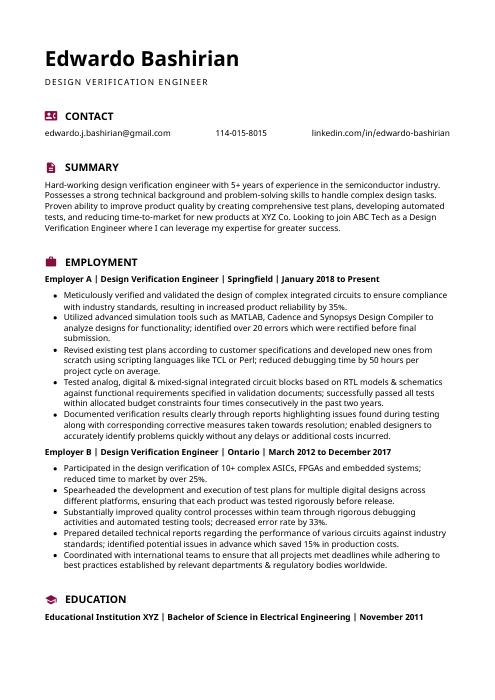 Hoopoe
Hoopoe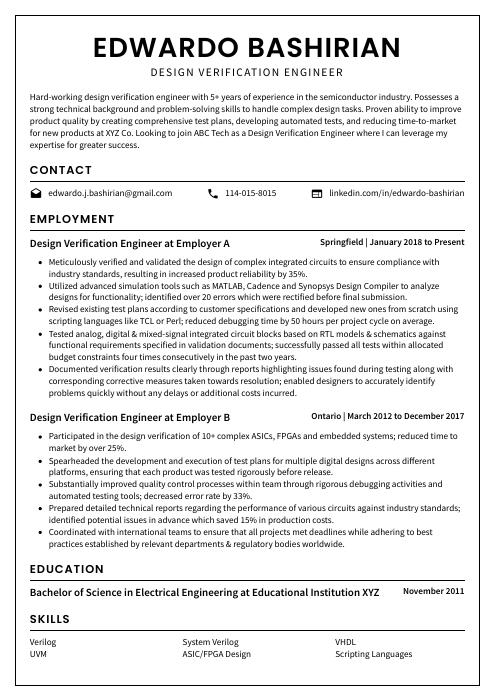 Cormorant
Cormorant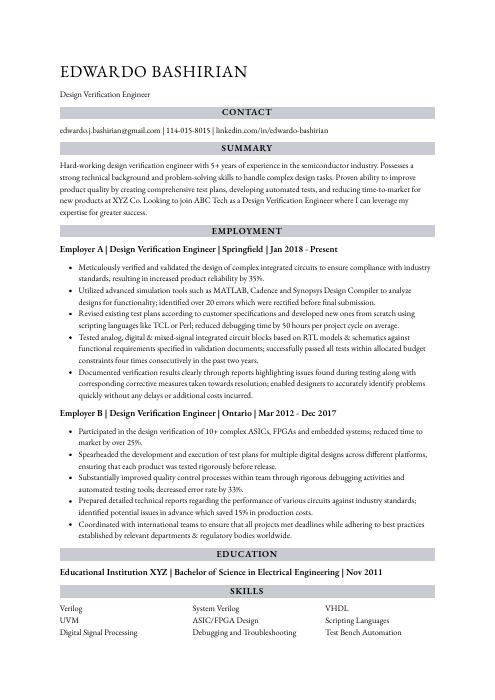 Numbat
Numbat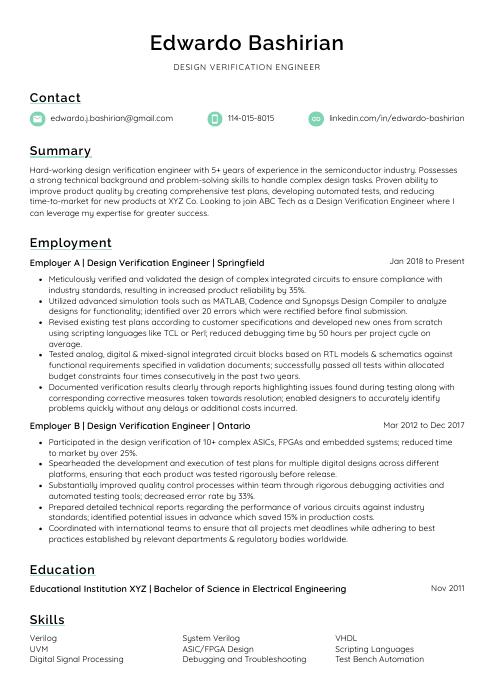 Lorikeet
Lorikeet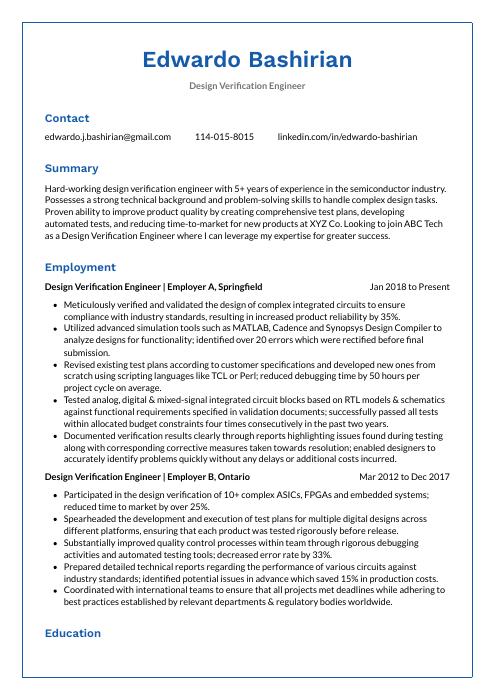 Markhor
Markhor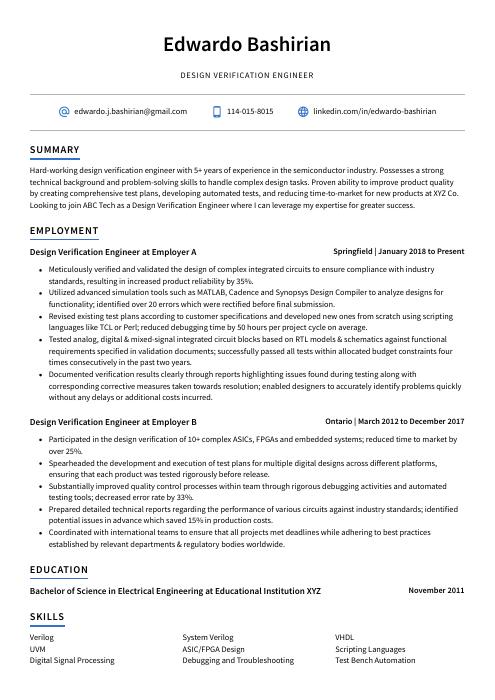 Axolotl
Axolotl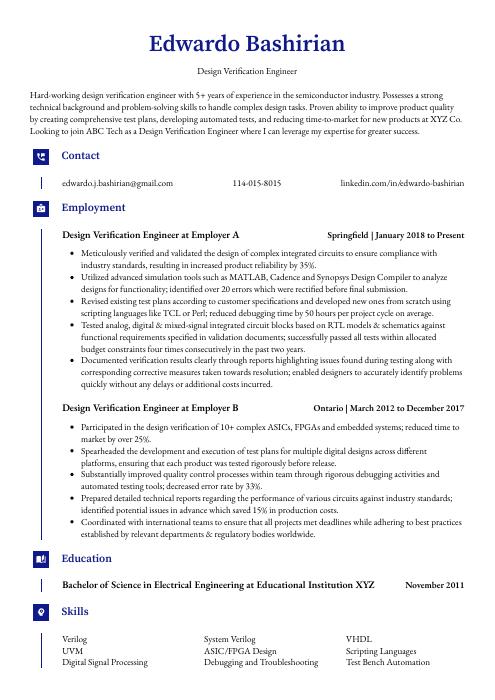 Gharial
Gharial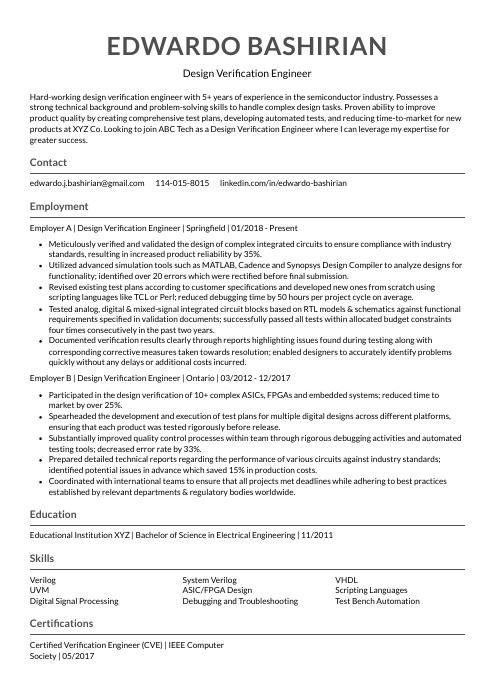 Indri
Indri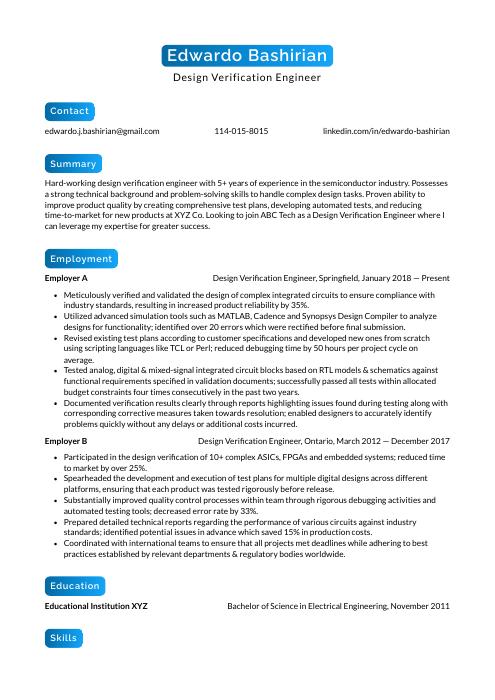 Kinkajou
Kinkajou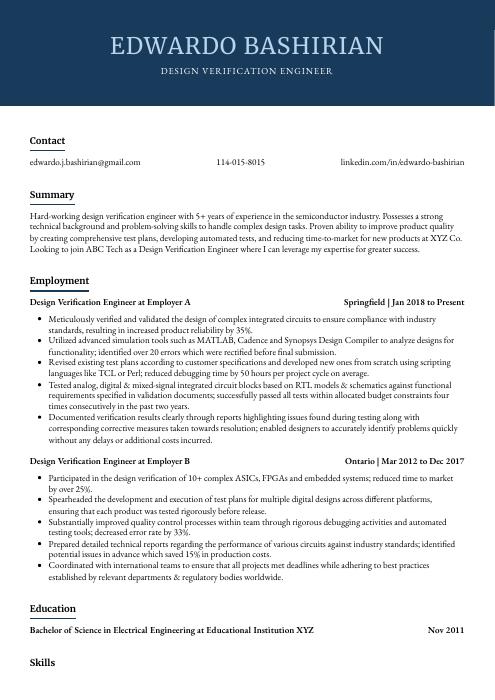 Bonobo
Bonobo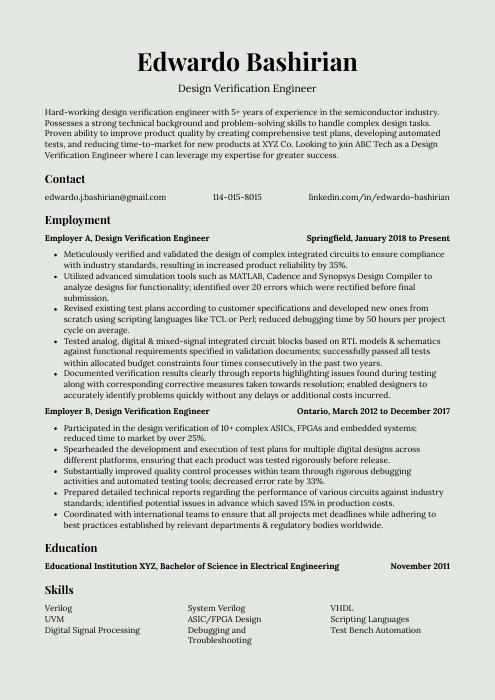 Saola
Saola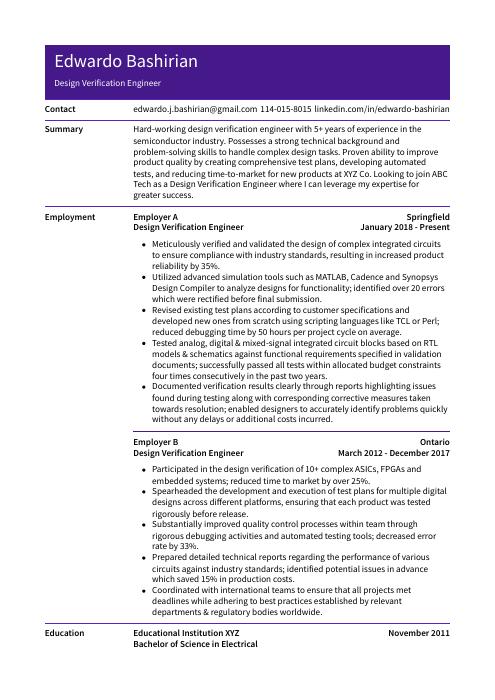 Pika
Pika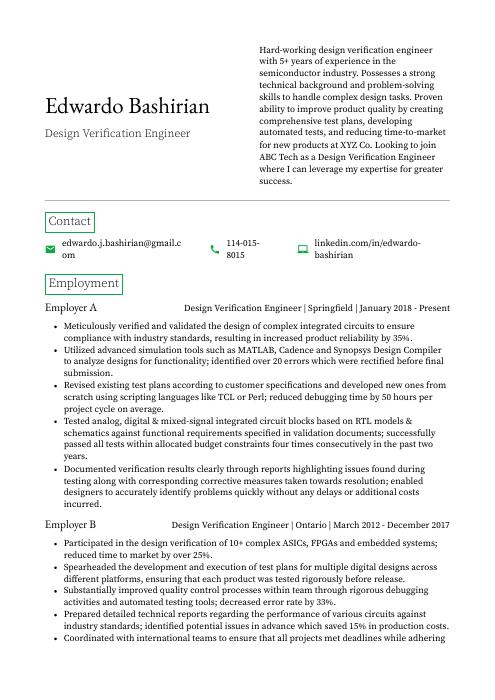 Quokka
Quokka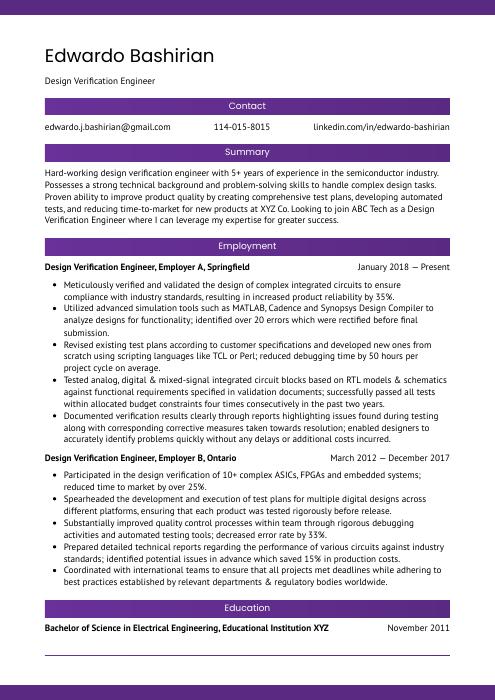 Jerboa
Jerboa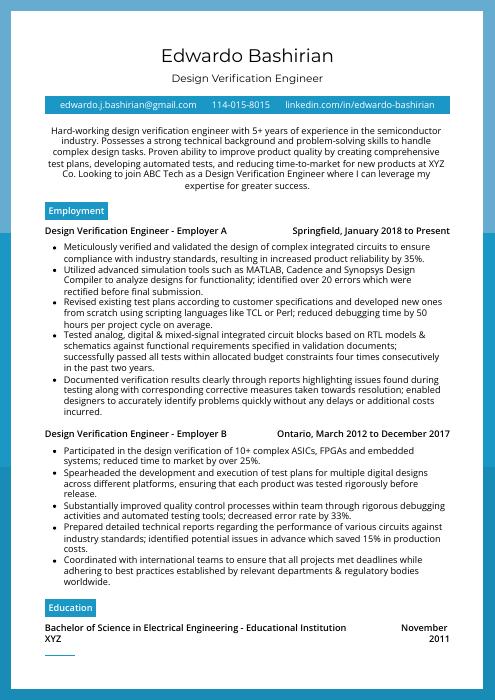 Rhea
Rhea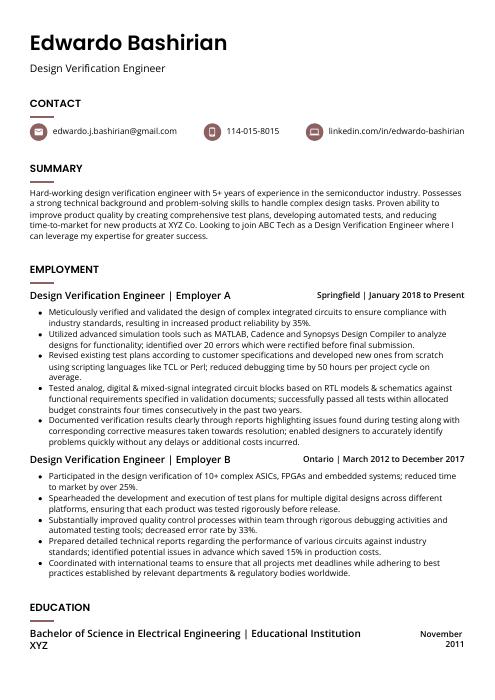 Fossa
Fossa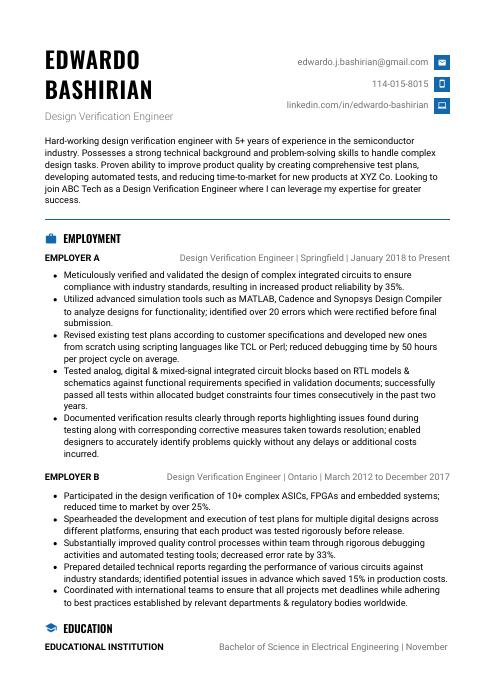 Echidna
Echidna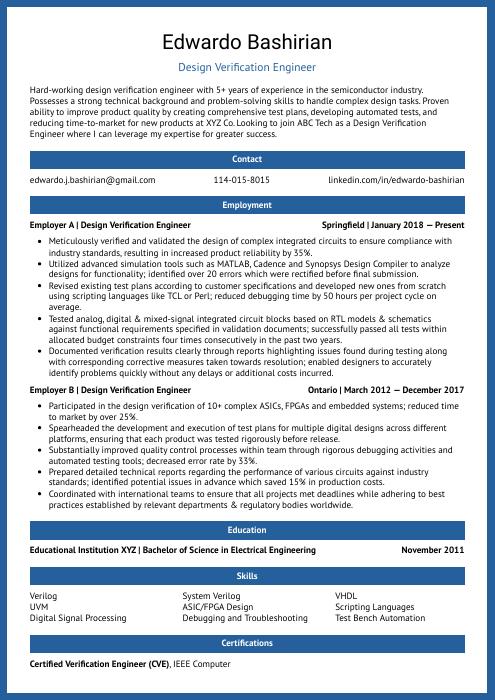 Ocelot
Ocelot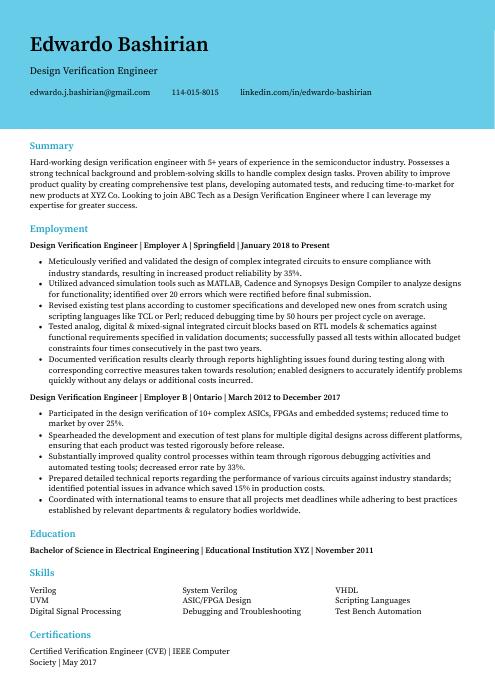 Dugong
Dugong Rezjumei
Rezjumei
